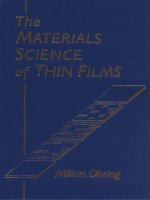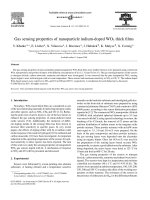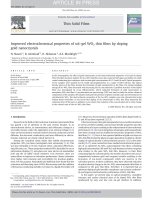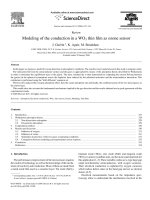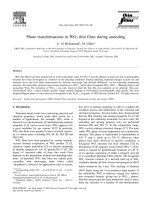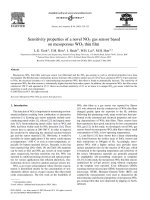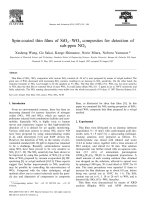- Trang chủ >>
- Khoa Học Tự Nhiên >>
- Vật lý
phase transformations in wo3 thin films during annealing
Bạn đang xem bản rút gọn của tài liệu. Xem và tải ngay bản đầy đủ của tài liệu tại đây (1.73 MB, 8 trang )
Thin Solid Films 408 (2002) 302–309
0040-6090/02/$ - see front matter ᮊ 2002 Elsevier Science B.V. All rights reserved.
PII: S0040-6090
Ž
02
.
00090-1
Phase transformations in WO thin films during annealing
3
A. Al Mohammad , M. Gillet*
1
UMR-CNRS, Laboratoire Materiaux et Microelectronique de Provence, Faculte des Sciences de Saint-Jerome, Universite D’Aix Marseille III,
´´ ´ ´ˆ´
52 Ave. Escadrille Normandie Niemen, 13397 Marseille Cedex 20, France
Received 30 June 2001; received in revised form 20 November 2001; accepted 2 February 2002
Abstract
WO thin films have been annealed in air in the temperature range 20–450 8C and the changes in grain size and crystallographic
3
structure have been investigated as a function of the annealing conditions. During annealing, important changes in grain size and
structure occur and have been characterised by electron microscopy and electron diffraction. As the annealing temperature
increases, the monoclinic structure successively transforms to WO Ø y H O phase, hexagonal WO , WO (Magneli phases) and
1
332 3 3yx
monoclinic WO . The formation of WO was only observed when the thin film was annealed on its substrate. This non-
33yx
stoichiometric WO phase exhibits specific fringe contrast imaging of well-ordered crystallographic shear planes. The most
3yx
frequent Magneli phase we have observed corresponds to the W O structure. ᮊ 2002 Elsevier Science B.V. All rights reserved.
40 118
Keywords: Atomic force microscopy (AFM); Oxides; Phase transitions; Transmission electron microscopy (TEM)
1. Introduction
Transition metal oxides have interesting physical and
chemical properties, which make them useful for a
number of applications. For example, WO oxide is
3
known for its electrochromic
w
1
x
and interesting catalytic
properties
w
2,3
x
, and in recent years, WO appears to be
3
a good candidate for gas sensors
w
4,5
x
. In particular,
WO thin films were reported to have excellent sensitiv-
3
ity to various gases, including NO
w
6–8
x
,HS
w
9
x
and
x 2
NH
w
10
x
.
3
WO films have been prepared by various methods:
3
vacuum thermal evaporation of WO powder
w
7,11
x
,
3
chemical vapour deposition
w
12
x
or reactive sputtering
of metallic tungsten by ArqO plasma
w
8,13–15
x
. The
2
degree of structural order of these thin oxide films
depends on the preparation method and annealing treat-
ment. As-deposited WO thin films are usually poly-
3
crystalline with short-range order (often called
‘amorphous’); however, for applications such as sensors,
*Corresponding author. Tel.: q33-4-91-28-83-71; fax: q33-4-91-
28-87-72.
E-mail address: (M. Gillet),
(A. Al Mohammad).
Permanent address: AECS, Damacus, Syria. Fax: q963-11-
1
6112289.
they have to undergo annealing in order to complete the
oxidation process and stabilisation of the structural and
electrical properties. Several studies have demonstrated
that the film structure and sensing properties
w
11,15,16
x
depend on the stabilising treatments. In most cases, the
annealing and sensing property tests are performed
between 200 and 500 8C. In this temperature range,
WO crystals undergo structural changes
w
17
x
. The most
3
stable WO phase at room temperature has a monoclinic
3
structure. This phase is transformed to orthorhombic at
330 8C and is stable up to 740 8C. However, other
phases have been observed in specific conditions: a
hexagonal WO structure has been obtained
w
18
x
by
3
dehydration of the tungsten oxide hydrate WO Ø y HO,
1
332
which is formed by hydrothermal treatment at 120 8C
of an aqueous suspension of either a tungsten acid gel
or a crystallised dihydrate (WO Ø2H O). The hexagonal
32
WO structure consists of a network built up of WO
36
octahedra sharing all their corners and arranged in (001)
layers normal to the -axis. The stacking of identical
™
c
(001) layers along the -axis produces large tunnels. If
™
c
the monoclinic WO is reduced, oxygen loss induces
3
new structural features, giving rise to WO phases.
3yx
Electron microscopy has been intensively used to deter-
mine the structure of a number of non-stoichiometric
303A. Al Mohammad, M. Gillet / Thin Solid Films 408 (2002) 302–309
Fig. 1. (a) Electron micrograph of an as-deposited WO thin film; (b) corresponding TED pattern; and (c) intensity profile: Is f (D)(Isdiffracted
3
intensity, Dsdiameter of the diffraction rings).
phases of tungsten oxides: WO (0-x-0.3)
w
19–
3yx
25
x
. These non-stoichiometric phases are derived from
the WO structure and have been interpreted in terms
3
of crystallographic shear planes
w
28
x
. This structure
consists of blocks of WO octahedra sharing corners
6
regularly separated by defect planes (crystallographic
shear planes). In these defect planes, WO octahedra
6
share their edges.
In this paper, we have investigated the changes in
granulometry and structure in thin tungsten oxide films
during annealing in air over a temperature range of 20–
450 8C. The WO films were annealed step by step,
3
with the structure observed after each step by transmis-
sion electron microscopy (TEM) and transmission elec-
tron diffraction (TED).
2. Experimental procedure
Thin WO films were prepared by evaporation under
3
vacuum of a WO powder (purity 99.99%). The residual
3
pressure was approximately 10 torr, the deposition
y5
rate approximately 15 Aymin and the film thickness
˚
approximately 300 A. WO was evaporated on (0001)
3
˚
a-Al O substrates maintained at 300 8C during depo-
23
sition. For TEM observations, the WO thin films can
3
be detached from their substrate in hydrofluoric acid.
After deposition, the thin tungsten oxide films were
annealed (either on or without substrate) in air with a
mean humidity of 68% in steps of 50 8C from room
temperature up to 450 8C. For each step, the annealing
time was 15 min. After each step, the structure was
observed by TEM. When annealed without substrate,
the thin films were taken off the substrate before
annealing and placed on a gold grid used for TEM
observations. We also performed experiments with con-
tinuous annealing and we found that, for a given
annealing temperature, the results are identical for a
cumulative step-by-step annealing and after continuous
annealing.
3. Results
During annealing, the grain size and structure of thin
oxide films considerably change. We have defined three
main temperature domains
w
20–100, 100–250 and 250–
450 8C
x
for which the WO thin film exhibits one or
3
two phases, according to the annealing temperature. For
an annealing temperature higher than 250 8C, the phases
observed depend on the presence of the substrate during
annealing.
3.1. 20–100 8C temperature range
During annealing at a temperature between RT and
200 8C, the structure and morphology do not change
significantly. The as-deposited film (Fig. 1a) exhibits
small crystallites with poor contrast and with a mean
diameter f2.5 nm. The TED pattern (Fig. 1b,c) shows
that the structure is monoclinic, with lattice parameters
as7.29, bs7.53 and cs7.68 A, bs90891, and most
˚
of the crystallites have a (001) plane parallel to the
substrate surface
3.2. 100–250 8C temperature range
In this temperature range, the WO thin films undergo
3
important changes with or without the substrate. A
recrystallisation takes place and the mean crystallite size
considerably increases, with a mean diameter of the
order of 100 nm. Fig. 2a is a typical electron micrograph
showing a common aspect of the annealed WO thin
3
film in the 100–250 8C temperature range. The TED
patterns indicate that various phases occur, according to
304 A. Al Mohammad, M. Gillet / Thin Solid Films 408 (2002) 302–309
Fig. 2. (a) Electron micrograph of a WO thin film annealed at 150 8C; (b) corresponding TED pattern; (c) intensity profile Is f (D) wPeak 1,
3
(002) monoclinic WO q(002) WO Ø y H O; Peak 2, (200) monoclinic WO ; Peak 3, (120) monoclinic WO ; Peak 4, (020) WO Ø y H O; Peak
1 1
3332 3 3 332
5, (201) monoclinic WO q(220) WO Ø y H O; and Peak 6, (220) monoclinic WO q(222) WO Ø y HOx; (d) TED of a WO film annealed
1 1
3332 3332 3
at 180 8C; (e) intensity profile Is f (D)(Peaks 1,2,3,4 and 5, hexagonal WO ; Peaks 19,29,39 and 49,WOØ y HO); (f) TED of a WO film
1
33323
annealed at 230 8C; and (g) intensity profile Is f (D)(the plane indices correspond to the hexagonal WO structure).
3
the annealing temperature; we define three temperature
steps where one or two phases are predominant.
3.2.1. Temperature step 100–150 8C
The TED pattern (Fig. 2b,c) shows that two phases
co-exist: monoclinic WO qWO Ø y H O. The hydrate
1
3332
WO Ø y H O crystallises in an orthorhombic structure,
1
332
with lattice parameters as7.35, bs12.51 and cs7.70
A
w
26
x
. Interpretation of the TED pattern agrees with
˚
this structure.
3.2.2. Temperature step 150–200 8C
A new hexagonal WO phase is observed and the
3
two phases WO Ø y H O and hexagonal WO coexist.
1
332 3
Fig. 2d,e shows the TED pattern of a WO film annealed
3
at 180 8C, showing the coexistence of two phases
WO Ø y HOqhexagonal WO . During this step, the
1
332 3
hydrated oxide WO Ø y H O phase is transformed to a
1
332
hexagonal WO structure, with lattice parameters as
3
7.29 and cs7.66 A
w
18
x
.
˚
3.2.3. Temperature step 200–250 8C
During this step, the mean grain size slightly increases
and the TED pattern becomes spotty and shows that the
oxide structure is hexagonal (Fig. 2f,g).
3.3. 250–400 8C temperature range
In this temperature range, we have observed different
structures, depending on the annealing procedure.
3.3.1. Films annealed without substrate
Fig. 3a presents a TEM micrograph of a WO thin
3
film annealed at 350 8C without substrate: two parts, A
and B, with different contrast can be observed and the
TED patterns show that they have different structures.
305A. Al Mohammad, M. Gillet / Thin Solid Films 408 (2002) 302–309
Fig. 3. (a) Electron micrograph of a WO thin film annealed at 350 8C without substrate; (b,c) TED patterns of parts A and B, respectively; and
3
(d) high-resolution micrograph of part B.
306 A. Al Mohammad, M. Gillet / Thin Solid Films 408 (2002) 302–309
Fig. 4. (a) Electron micrograph of a WO thin film annealed on a-
3
Al O substrate at 350 8C. wThe imaged structure corresponds to
23
WO (WO ). The black lines correspond to the shear planes
2.95 40 118
parallel to (100) planes.x (b) Corresponding TED pattern.
Part A (Fig. 3b) has a monoclinic structure and part B
(Fig. 3c) corresponds to the hexagonal WO structure.
3
Thus, in this temperature range, the hexagonal WO and
3
monoclinic WO phases coexist and the observation
3
demonstrates that the WO hexagonal structure is trans-
3
formed to monoclinic WO phase. For an annealing
3
temperature above 400 8C, only the monoclinic WO is
3
observed.
The thin film with monoclinic structure (part A in
Fig. 3b) exhibits a typical contrast with parallel strips.
This contrast has been interpreted as being twinned
microdomains elongated in the
w
100
x
direction, with a
twinning (001) plane and a surface plane parallel to the
(010) plane
w
27
x
. Part B of the film corresponds to the
hexagonal WO structure, which often presents holes
3
with a hexagonal shape and seems to be formed by the
stacking of thin layers with poor contrast. These hex-
agonal WO layers have their surface parallel to the
3
(0001) plane. Fig. 3d is a TEM micrograph correspond-
ing to the thin hexagonal WO part with a (0001) plane
3
parallel to the surface. The contrast can be considered
as a projection of the hexagonal structure on a plane
perpendicular to the incident electron beam. This con-
trast is in good agreement with the existence of large
tunnels separated by 7.7 A and arranged in hexagonal
˚
rings.
3.3.2. Films annealed with their substrate
When annealed on their Al O substrate in the tem-
23
perature range 250–400 8C, the thin tungsten oxide
films exhibit a typical contrast observed by electron
microscopy. Fig. 4a is an example of the electron
micrographs observed for tungsten oxide annealed at
350 8C on its Al O substrate. This electron micrograph
23
exhibits fringe contrast resulting from ordered plane
defects perpendicular to the film plane. Such defects
occur in slightly reduced crystals (WO ), where the
3yx
oxygen loss is accounted for by a shearing process
(crystallographic shear structures or Magneli structure)
w
28,29
x
. Several electron microscopy studies have dem-
onstrated that such structures are relatively common in
non-stoichiometric oxide with a ReO -type structure
3
w
19,24,25,31,32
x
. The possible crystallographic shear
planes ( CS planes) have low indices of type (1k0)(with
ks1,2,3,«). For a phase with a given structure, the CS
planes are parallel to and separated by slabs of the
WO mother structure, the thickness of which depends
3
on the phase composition. In the micrograph of Fig. 4a,
the fringe equidistance measured is ds17"1 A. The
˚
corresponding TED pattern is shown in Fig. 4b. It
exhibits two kinds of diffraction spots: spots with a
strong intensity provided by the WO mother structure
3
and super spots with a lower intensity located between
the main spots. These super spots given by the ordered
defects (CS planes) parallel to the (100) planes of the
mother structure correspond to the super lattice of the
CS structure. From the TED pattern, we deduced that
the WO phase observed is W O (WO ) with
3yx 40 118 2.95
an orthorhombic cell, the lattice parameters of which
are as7.3, bs33.9 and cs7.7 A.
˚
On various WO thin films annealed at a temperature
3
of approximately 350 8C, we observed several other
WO structures, which are imaged with fringes sepa-
3yx
rated by a specific distance (for example, the W O
20 58
CS structure with fringes separated by 23 A). On the
˚
same specimen, it is possible to observe two or three
different CS structures corresponding to different
compositions.
3.4. 400–450 8C temperature range
As previously mentioned, tungsten oxide films
annealed without substrate at a temperature above 400
8C exhibit only the monoclinic structure. For oxide film
annealed on an Al O substrate at 400 8C, we observed
23
transformation of the WO phases to monoclinic
3yx
WO . Fig. 5 is an electron micrograph that illustrates
3
this transformation: part B exhibits a fringe contrast
identical to the contrast in Fig. 4a and corresponds to a
non-stoichiometric WO phase with a CS structure
3yx
(WO ). Part A, which lies on both sides of part B,
40 118
has a different contrast and the TED pattern indicates
that the structure is monoclinic.
4. Discussion
When annealed on their substrates at a temperature
higher than 250 8C, the thin tungsten oxide films exhibit
WO CS structures. This observation emphasises the
3yx
role of the substrate during recrystallisation. The sub-
307A. Al Mohammad, M. Gillet / Thin Solid Films 408 (2002) 302–309
Fig. 5. Electron micrograph of a WO thin film annealed at 420 8C,
3
showing transformation of the WO structure to the monoclinic
3yx
WO structure.
3
strate has two main effects: (1) the film is epitaxially
oriented and the grain size increases; and (2) in large
epitaxial grains, the CS planes are easily observed by
TEM and TED. This does not mean that such defects
resulting from oxygen deficiency do not exist in smaller,
misoriented grains (annealed without substrate); how-
ever, they are probably only embryonic, with no specific
contrast in TEM and no well-defined diffraction spots
in TED.
During annealing, we observed successive phases:
With low annealing temperatures (T -200 8C) the
A
oxide films are composed of small crystallites, which
can react with the moisture of the air and give a hydrate.
During annealing at temperatures T )200 8C, the water
A
is desorbed and the hexagonal WO phase is formed by
3
dehydration
w
18
x
. The hexagonal phase occurs because
of the similarity between the atomic arrangement of
WO Ø y H O and the hexagonal WO structure. In the
1
332 3
same way, the hexagonal WO is easily transformed to
3
monoclinic WO due to the crystallographic similarity
3
of the two lattices.
A W–O phase diagram has been proposed by Shunk
w
30
x
. This diagram exhibits only two stable non-stoichi-
ometric phases, W O and W O at 420 and 550 8C,
20 58 18 49
respectively. The WO structures we observed have
3yx
already been observed by TEM of non-stoichiometric
oxides of R O structures
w
30
x
. We observed W O
e 3 20 58
(WO ) formed at an annealing temperature of 400 8C,
29
in agreement with the phase diagram of Shunk. How-
ever, the W O (WO ) phase frequently observed
40 118 2.95
is not reported in the phase diagram of Shunk. This
result concerns thin oxide films, which can exhibit some
specific metastable structures.
The final structure of WO observed in thin films
3
annealed in air at 450 8C is the monoclinic structure,
with WO in variable proportions. This monoclinic
3yx
structure always presents extensive micro-twinning,
which is a characteristic feature of such structures
w
33–
35
x
. However, it is well known that the monoclinic
phase, which is stable between RT and 330 8C, trans-
forms to an orthorhombic structure above 330 8C
w
17
x
.
To explain the monoclinic structure observed in this
work, there are two hypotheses: either (1) the thin films
(our films have of a thickness -500 A) have a specific
˚
structure and do not experience the phase transition at
330 8C; or (2) the orthorhombic structure formed during
annealing above 330 8C is reversibly transformed to
monoclinic phase when the temperature decreases down
to RT, which is the usual temperature for TEM
observation.
Recently, a number of experiments have demonstrated
that WO thin films are particularly interesting for their
3
sensing properties and that non-stoichiometric structures
are involved in the mechanism of film conductivity
because of the free electrons originating from oxygen
vacancies. Annealing in the 300–450 8C temperature
range leads to WO films with variable stoichiometry.
3
We observed a WO oxygen-deficient structure with
3yx
characteristic fringe contrast (Magneli phase) with well-
defined stoichiometry, in which oxygen vacancies are
concentrated in well-ordered defect planes. WO has
3
large flexibility to accommodate oxygen deficiencies
through the formation of CS planes. Thus, various
WO phases with 0)x)0.3 can occur, giving differ-
3yx
ent CS structures, as we have observed. When the shear
vector of the CS planes has a component normal to the
surface plane, which is the case for the CS structures
that we have observed, a small step is created along the
CS plane–surface intersection. We can expect that these
types of defects (CS planes) contribute to the surface
reactivity. It is possible that, for slightly reduced films,
the WO structure includes only some CS planes (or
3
embryos of shear planes) randomly arranged. In all
cases, the formation of the CS planes gives new atomic
co-ordination, in which the WO octahedra share their
6
edges and the W species are reduced to W .
6q 5q
5. Conclusion
Table 1 summarises the main results for the various
structures observed during annealing of WO thin films.
3
The thin films were obtained by evaporation under
vacuum of WO powder and deposition on a (0001)
3
Al O substrate. The as-deposited films are so-called
23
amorphous, formed of very small crystallites of mono-
clinic structure, which react with moisture in the atmos-
phere. During annealing at low temperature T -200
A
308 A. Al Mohammad, M. Gillet / Thin Solid Films 408 (2002) 302–309
8C, the hydrate WO Ø y H O occurs. When the oxide
1
332
film is annealed at a temperature )200 8C, the grain
size considerably increases. During recrystallisation, the
hydrate is transformed to hexagonal and monoclinic
WO . The final monoclinic structure exhibits Magneli
3
phases, which are characteristic of non-stoichiometric
structures and give specific defects on the film surface.
We think that these intrinsic defects, which depend on
the annealing procedure (temperature and substrate),
play an important role in the electronic conductivity,
and consequently in the sensing behaviour. Thus, we
plan to carry out further investigations into the surface
structure of WO thin films and the corresponding
3
conductivity to clarify the role of defect formation in
sensing properties.
References
w
1
x
J.S.E.M. Svensson, C.G. Grancqvist, Sol. Energy Mater. 11
(1984) 29.
w
2
x
F.A. Cotton, G. Wilkinson, Advances in Organic Chemistry,
5th ed., Wiley, 1988, p. 829.
w
3
x
G. Sberveglieri, Recent developments in semiconducting thin
film gas sensors, Proceedings of ESS ’94, World Scientific,
Singapore, 1995, pp. 37–48.
w
4
x
G. Sberveglieri, L. Depero, S. Groppelli, P. Nelli, WO sput-
3
tered thin films for NO monitoring, Sensors Actuators B 26y
x
27 (1995) 89.
w
5
x
N. Yamazoe, N. Miura, New approaches in the design of gas
sensors, in: G. Sberveglieri (Ed.), Gas Sensors, Kluwer, Dor-
drecht, 1992, pp. 1–42.
w
6
x
C. Cantaalini, H.T. Sun, M. Faccio, M. Pelino, S. Santucci, L.
Lozzi, M. Passacantando, Sensors Actuators B 31 (1996) 81.
w
7
x
M. Akiyama, Z. Zhang, J. Tamaki, N. Miura, N. Yamazoe, T.
Harada, Sensors Actuators B 13-14 (1993) 619.
w
8
x
M. Penza, M.A. Tagliente, L. Mirenghi, G. Gerardi, C. Mar-
tucci, G. Cassano, Sensors Actuators B 50 (1998) 9.
w
9
x
A. Agrawal, H. Habibi, Thin Solid Films 169 (1989) 257.
w
10
x
H. Meixner, J. Gerblinger, U. Lampe, M. Fleischer, Sensors
Actuators B 23 (1995) 119.
w
11
x
D. Manno, A. Serra, M. Di Giulio, G. Micocci, A. Tepore,
Thin Solid Films 324 (1998) 44.
w
12
x
P. Tagtstrom, U. Janson, Thin Solid Films 352 (1999) 107.
¨¨
w
13
x
H.M. Lin, C.M Hsu, H.Y. Yang, P.Y. Lee, C.C. Yang, Sensors
Actuators B 22 (1994) 63.
w
14
x
Z. Xu, J.F. Vetelino, R. Lee, D.C. Parker, J. Vac. Sci. Technol.
A4(1986) 2377.
w
15
x
X.G. Wang, Y.S. Jiang, N.H. Yang, L. Yuan, S.J. Pang, Appl.
Phys. Sci. 143 (1999) 135.
w
16
x
L.E. Depero, S. Groppeli, I. Natali-Sora, L. Sangaletti, G.
Sberveglieri, E. Tondello, J. Solid-State Chem. 121 (1996)
379.
w
17
x
E. Salje, K. Viswanathan, Acta Cryst. A 31 (1975) 356.
w
18
x
B. Gerand, G. Nowogroski, J. Guenot, M. Figlarte, J. Solid-
State Chem. 29 (1979) 429.
w
19
x
R.J.D. Tilley, Mater. Res. Bull. 5 (1970) 813.
w
20
x
J.G. Allpress, R.J.D. Tilley, M.J. Sienko, J. Solid-State Chem.
3 (1971) 440.
w
21
x
J.G. Allpress, G. Gado, Cryst. Lattice Defects 1 (1970) 331.
w
22
x
L.A. Bursill, B.G. Hyde, J. Solid-State Chem. 4 (1972) 430.
w
23
x
M. Sundberg, T.J.D. Tilley, J. Solid-State Chem. 11 (1974)
150.
w
24
x
S. Ijima, J. Solid-State Chem. 14 (1975) 52–65.
w
25
x
R. Pickering, R.D.J. Tilley, J. Solid-State Chem. 16 (1976)
247.
w
26
x
B. Gerand, G. Nowogroski, M. Figlarz, J. Solid-State Chem.
38 (1981) 312–320.
w
27
x
M. Gillet, A. Al Mohammad, C. Lemire, Thin Solid Films,
submitted for publication.
w
28
x
J.S. Anderson, B.G Hyde, J. Phys. Chem. Solids 28 (1967)
1393.
w
29
x
S. Anderson, A. Magneli, Naturwiss 43 (1956) 495.
309A. Al Mohammad, M. Gillet / Thin Solid Films 408 (2002) 302–309
w
30
x
F.A. Shunk, Constitution of Binary Alloys, McGraw Hill, 1969,
Suppl. 2, p. 586
w
31
x
K. Kossuge, H. Okinaka, S. Kachi, K. Kagasawa, Y. Bando,
T. Takada, Jpn. J. Appl. Phys. 9 (1970) 1004.
w
32
x
J. Van Landuyt, S. Amelinks, Mater. Res. Bull. 5 (1970) 267.
w
33
x
N.R. Averty, Surf. Sci. 33 (1972) 107.
w
34
x
A.E. Lee, K.E. Singer, Proc. R. Soc. Lond. 323 (1971)
523–539.
w
35
x
R.A. Dixon, J.J. Williams, D. Doris, J. Rebane, F.H. Jones,
R.G. Egdell, S.W. Downes, Surf. Sci. 399 (1998) 199.
